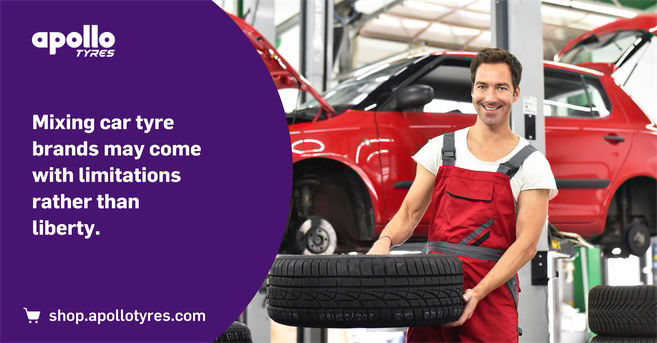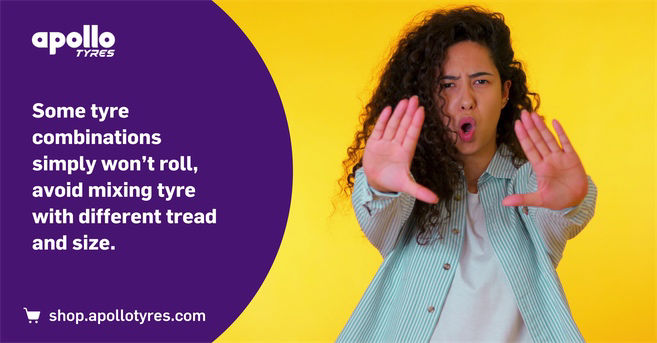
Pro drivers often mix and match tyres to get the most out of their vehicles. Mixing and matching tyres is an art and requires in depth knowledge. If done right, mixing tyre brands can help improve handling, ride quality, and fuel economy. But for regular drivers mixing and matching tyres is generally not recommended. In today's post we have a look at the pros and cons of mixing tyre brands.
Why car manufacturers don't mix and match tyre brands?
You will seldom find a car with mixed and matched stock tyres. Car makers avoid this practice as they claim it can create safety and performance issues. Hence, you find the same make and tyre models on all stock vehicles sold through dealerships. Although, car makers do use different tyre models for variants of the same vehicle. For example, the base model of a Maruti Swift may come with a different brand of tyres. Whereas you will find the Apollo Alnac 4G tyres on top-spec versions.
Also, the car maker is best placed to decide the ideal tyre for a car or SUV. As manufacturers, they know the type of tyre that is best suited for a particular vehicle. For doing so, they consider several things, such as the construction method, tread pattern, speed rating, and load index.
Pros and Cons of mixing car tyre brands

As mentioned earlier, mixing tyre brands and tyre types is not without its merits. When done with pro help, it can improve your driving experience. For example, for a commercial vehicle, you can use high-mileage tyres at front and load bearing tyres at the back. Or, you can use a mix of low road noise tyres and low rolling resistance tyres for your personal car.
Pros of mixing car tyres
While universally applicable, these pros mostly benefit high performance vehicles. For daily use cars and SUV, driven in city or highways, the benefits are negligible. Here are the pros of mixing tyre brands and tyre treads:
- May improve fuel efficiency
- May improve ride and handling
- May help carry heavier loads
- May increase braking performance
- May lower noise, vibration and harshness (NVH) levels
- May make the vehicle swifter
And, if you end up with the wrong combination of tyres, it might affect your vehicle's performance.
Cons mixing of car tyres
Every tyre brand creates tyres that cater to a specific audience. For example, Apollo Tyres, as an Indian tyre brand is best suited for our cars, roads, and drivers. A European tyre brand may not be using the same rubber compounds and tyre technologies needed for local driving conditions. So, when you mix an Indian tyre brand with a foreign tyre brand, you may get mixed results. Here are the cons of mixing tyre brands:
- May cause reduced fuel economy
- May ower ride quality and handling
- May educe braking performance
- May cause increase in noise, vibration, and harshness (NVH) levels
- May cause increased or in-equal tread wear
- May reduce pick up and speed
- May lead to unsatisfactory loading performance
- May cause wheel alignment and balancing problems
As you can see, incorrect mixing of tyres can cause a bunch of problems. These can be easily avoided if you stick to regular car tyre replacement. Because frankly speaking, regular car drivers do not need such elaborate tyre replacements. Buying the same brand car tyres for all four wheels will ensure uniform performance. And car makers also recommend the same.
But sometimes mixing car tyres becomes unavoidable
You may find yourself in a situation where one or more of the tyres get damaged and need replacement. But the tyre dealer you visit does not stock the brand you were using. In such cases, try to match the tyre size, load, and speed rating to the closest available. Also, depending on the type of your vehicle, try to match similar tyres on front and rear axles. For example, if you have a commercial vehicle, keep the load bearing tyres on the rear axles.
What to do when replacing only two tyres?
Car owners often find themselves in this dilemma. In cars, the front tyres often have more wear than rear tyres. So, car owners choose to replace two tyres at a time. In such a situation, using same brand tyres on one axle is recommended. Here's our guide to replacing only two car tyres:
- Buy the exact same tyre to replace the worn out tyres - Best Solution
- If the exact same tyre is unavailable or discontinued, try a similar tyre from the same brand
- If the only option is buying a tyre that does not match vehicle specifications, use it as temporary solution
Eventually, try to buy all four tyres from the same brand (of same model). Because that will guarantee uniform performance.
Can you mix different tread depths?
When you are replacing only two tyres, it may be that the tread depth will differ. You can mix tyres with different tread depths. Minor difference in tread depths (up to 2/32") are permissible between front and rear axles. But tyre specialists recommend fitting the new tyres on rear axle.
Here's why?
Tyres with lower tread depth lose their water dispersion qualities. In car tyre terms, it is known as hydroplaning. Hydroplaning occurs when water on the road cannot flow under the tread pattern. In such cases, the vehicle loses contact with the road and slips. Hydroplaning can affect handling, steering, balance and traction and compromise your safety.
Having greater grip on the rear axle helps you avoid spin out situations. Stable grip on the rear axle also keeps the steering controls active on slippery roads.
Which tyres combinations to avoid when mixing tyres?

There are certain types of tyres that should not be combined at all. Here's what car tyre experts opine:
- Tyres with different tread patterns
- Pairing tyres of different sizes (unless specified by the carmaker)
- Winter tyres, summer tyres, and all-season tyres in any combination
- Run flat tyres with normal tyres
- Low rolling resistance tyres with resistant tyres
- Regular tyres with off-road tyres
Concluding thoughts
Mixing tyres does have its benefits but only for the most informed drivers. A normal person can get the best performance by sticking to the simple rule "exact same tyres on all four wheels". It helps you avoid the overthinking and hassle that comes with car tyre replacements. Moreover, automakers also recommend using the same tyre brand and model for all wheels, so why bother? Buy the same tyres for all your wheels.
Now, buying new car tyres is all the more easier with our online tyres shop.
Frequently Asked Questions:
Can I use different brands of tires on my car?
Yes, you can use different brands of tires but it’s not recommended by tire experts and automakers. For the best performance always try to exact match your car tires vis-à-vis tyre brand and model. Otherwise you may face performance issues and can even face road hazards.
Should the front and rear tires on my car be the same?
Ideally, yes. Having the same tyres on all four wheels is the best recipe for getting maximum fuel-efficiency, tyre mileage, and driving comfort. But in case you are replacing only two tyres and the exact brand and model are not available, at least use same set of tyres on each axle.
Do different brand tyres have different tread depths?
Yes, different tyre brands are bound to have difference in tread pattern and tread depth. It is not recommended to use tyres with drastically different tread patterns on all four tyres or on each axle. If you are replacing old tyres, always try to match the tread pattern and always use the new tyres on the rear axle.
Why is tire rotation beneficial?
Tire rotation helps in getting the best tyre mileage. As front axle tires are prone to rapid wear, rotating tires at specific periods also ensures uniform tread wear on all four tyres. Which means you can buy all four tires at once when going for replacement, instead of wearing out any two and facing the dilemma of mixing car tyres.

